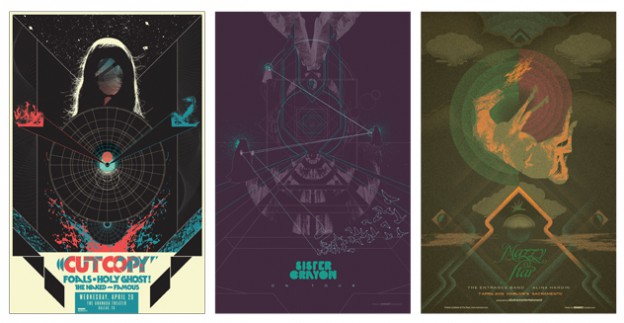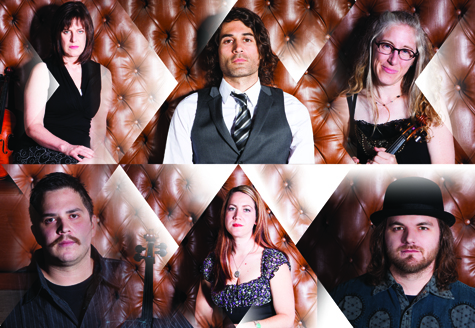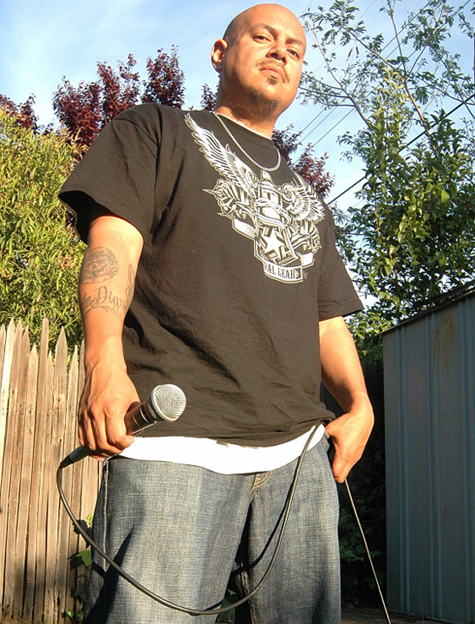Soulful, Danceable and Real, Groovincible Plans to Get You Moving with Their New Album
If you are ever in search of a vocalist and partner in crime, you might try spotting the flyest girl in the bar and asking her to sing for you. The odds that she will deliver are slim. But it must have been Matt Klee’s lucky night, because Bianca Wright sang him a song she wrote that left an impression, and the two have been side by side musically and romantically ever since.
Three years later, Wright and Klee joined Jacob Gleason to form Groovincible in 2011 in Klee’s garage in Fair Oaks. The idea was to put Wright’s voice at the forefront of the band, with Klee on drums, Gleason on guitar and tenor sax and Wright on the mic, shared with Gleason. Prior, Gleason and Klee bonded over tacos and hours spent in the backseat of a crusty old tour van during the 2009 Hippy Feet tour with Sacramento’s well-known fusion band ZuhG. Each have been involved in other musical projects, including ZuhG, but after Wright performed as a guest singer on Free Love, ZuhG’s self-released album, the three broke away to form Groovinicible, allowing them an opportunity to write their own material.
Now, after wrapping up their self-titled debut album recorded at Pus Cavern Studios (currently available for purchase and streaming online) they are prepping for their CD release show, which is on Saturday, July 27 at Blue Lamp. They have also added on three members: Tony Marks on bass, Sam Phelps on keys and Edward Hurff on baritone sax.
If you’re limited on words, you could say Groovincible is somewhere in the funk/soul/jazz realm, with moments of rock. Their aim is to keep things grooving, interesting and danceable, hence “Groovincible.” Those are the words that Gleason offered up during a phone interview with him and Wright. But that’s just brushing the surface.
For those who like to turn on a dynamic album and listen the whole way through, Groovincible is for you. Just when you think you’ve heard it all, the band pulls something else out of their sleeve, whether its ethereal harmonies or tempo changes and distortion.
In the span of 43 minutes laid over 12 tracks, Groovincible throws one drop (the reggae groove), Klezmer, tablas (Indian drums) and distorted sax into the mix. Of the 12, only four are under five minutes in length, and two of the songs are broken up over two tracks. That’s just how Gleason writes, with at least three “parts” per song.
As he explains it, a song amounts to “whatever amount of time it takes to express the idea,” whether it’s five minutes or 30.
This album evolved out of several months of Klee and Gleason jamming in Klee’s garage. Everything was recorded. At the end of the recording sessions they cut out whatever didn’t sound good from each track, leaving behind the cream of the crop to make up the songs. Gleason actually ended up cutting out a lot of guitar, leaving “implied” guitar parts in a number of songs while layering saxophone, keys, bass and flute.
The exception was a “magical take” of “Bari Krishna,” recorded in one go. “Bari Krishna,” with the overlap of fluttering guitar and horn segments, brings to mind a chase scene in a spy film, blazing through alleys in a getaway car in Cairo or Kabul.
Other songs, such as opening track “Downtown Shindig” or “Punk Step,” could easily sound off during one of Quentin Taratino’s killing sprees.
As far as Gleason is concerned, if their songs have cinematic flavor, then they are succeeding.

Aside from “Bari Krishna,” which is instrumental, Gleason and Wright wrote the vocals over the songs, with Wright penning a lot of the hooks and choruses, and adding a soulful touch.
“A lot of people homogenize soul, R&B and hip-hop,” Wright says. “But when people are singing they’re really pushing for what they’re inspired by… My lyrical style is more soulful.”
She takes her cues from the likes of Jill Scott and Erykah Badu.
Beyond recording, Wright’s feminine energy is critical to the band, Gleason says.
As Wright sees it, she contributes both nurturing and vulnerable elements to the band, particularly during live performances.
“If I’m going to be up there on stage, then I like everything I do to be ‘real,’” Wright explains. “I like to set the vibe and be comfortable with people, looking at people, looking at who I’m singing to.”
While Wright brings the soul, it is apparent that Gleason brings the glue. Or is the glue, when it comes to the band. That includes music theory and recording.
“I live, eat and dream music,” he says.
While it’s definitely not an unusual thing to hear coming from a musician, it doesn’t feel like false advertising. He’s one of those who got an early start in music theory, coming from an upbringing where instruments and encouragement were consistently available, starting with mom breaking out the pans, to a keyboard, saxophone and eventually a guitar. By age 15 he was in his first rock band, and music has been an everyday part of life ever since.
“I sit on my ass and watch Game of Thrones once in a while,” he confesses.
Beyond that, however, time boils down to songwriting and performing.
However they manage to do it, between Gleason, Wright and Klee and those who have hopped on board since, Groovincible has developed an unmistakable sound.
“We’re just a bunch of people who make noise together,” Gleason says. “We get to play music we love with people we love.”
Whether or not Klee realized it at the time, he was doing everyone a favor when he asked Wright to sing.
Groovincible’s CD Release show is Saturday, July 27, 2013 at Blue Lamp (1400 Alhambra Blvd). Also performing will be Tao Jiriki and Brian Rogers. $10 cover includes the new Groovincible CD. Doors open at 8 p.m., show starts at 9 p.m., 21-and-over only. For more information visit Groovincible.com
How local graphic designer and poster artist Jason Malmberg came up through the ranks
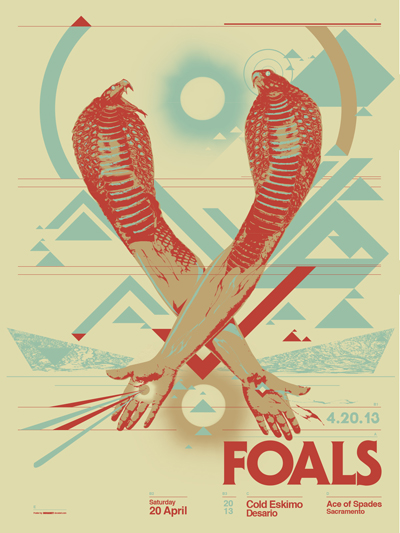
If you look at a Jason Malmberg poster and you’re unsure at first of what you’re looking at, if you need a minute to stare and process, if things seem off balance, if for a moment you feel like you are looking at a worksheet out of a German school book—don’t be alarmed. This is just the effect the local graphic designer is going for.
In the ‘70s, even public service announcement posters were psychedelic, Malmberg remembers, including one he’ll never forget. It was of a sobbing child throwing his arms over his head in horror, except his arms were 13 or 14 snakes. The poster read, “Why you shouldn’t take LSD” and went on to list what happens in the first 15 minutes, and in the second.
Take a look at the poster Malmberg made for the Foals show at Ace of Spades last month, and in the midst of colliding geometric shapes, you’ll see two intersecting male arms, each turning into the head of a snake from the elbow up.
Malmberg sampled two to four hands, arms and snakes to put together that image alone. “I don’t like hacking on other images,” he explains over the phone from his home office. “I want it to be more my own.”
So he salvages bits and pieces from historical images and online library archives public libraries, sometimes drawing on top of them, to recreate entirely new concepts, often with a ‘60s and ‘70s feel. Then he’ll lay out some type—and as a self-proclaimed typography nerd, this is key.
For the last 13 years, Malmberg has designed posters for just under 100 shows, including mainstream acts like Mos Def and the Violent Femmes as well as indie rock band Foals and former underground pop band Luna. Next month, he will showcase some of his pieces in his second-ever poster art show, Modern Lehzure, at Cuffs in Midtown.
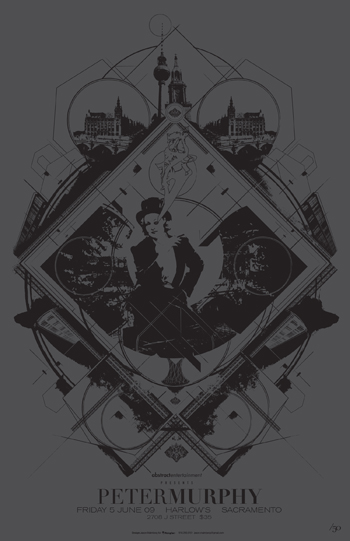
Visit Decabet.com and you will get a taste of Malmberg’s work. Yes, decabet, as in Dan Aykroyd’s 10-letter alphabet on Saturday Night Live.
Poster design is Malmberg’s ultimate outlet. What he hasn’t been able to get away with in his day job, he has gotten away with in poster art.
Within the last year Malmberg landed a job with a branding agency in Washington, D.C, where he is now developing his Web skills. Before that, he worked in print, as an art director for a handful of local publications, like Sacramento News & Review, Sactown Magazine and MGW.
While he was with Sactown Magazine, one of his designs popped up on T-shirts at Nordstrom sometime in 2007. You’d never know it, he says, and that’s probably all for the best. Unfortunately, his unique filigree design somehow became a part of the douche bag national uniform, he discloses.
Regardless, life wasn’t always peachy for Malmberg. If anyone has earned the seat they are sitting in now, he certainly has. It took a lengthy series of events to get him here.
To put it bluntly, “I’ve worked every shitty, low-paying job you could imagine,” he says.
This includes working fast food joints, at an eyeglass factory, in furniture assembly and smoothing down edges of windshields for eight hours a day.
Malmberg’s beginnings took place in Omaha, Neb. His teen years preceded Saddle Creek Records.
“It’s still not really cool to be from Omaha, but more than it was when I was there,” he says. “Now Omaha is sort of like a mini Athens kind of city—not Greek obviously—with their hipster cred. I was there in 1999, when it was a terrible wasteland and our claim to fame at the time, which everyone is still trying to live down, is 311.”
He studied under a “hands-off” kind of art teacher in the Omaha suburb of Bellevue, who provided Malmberg with just the right amount of guidance that made him successful. He had gallery shows before graduating from high school and went on to study at the Art Institute of Chicago.
Unfortunately, along with admittance into one of the best art schools in the country came unlimited pretentiousness.
He was surrounded by art students. To his dismay many of them were kids desperately attempting to fit social roles and convince the world they were someone other than themselves.
He quickly came to this realization: “I love people who make art, but I hate artists.”
He also realized that the Art Institute was not for him.
“I was making less art than when I was just a bum working at Taco Bell,” he remembers.
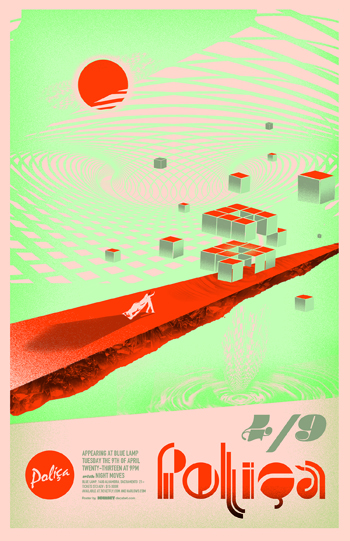
So, a year into it, Malmberg did what many students who find themselves in similar situations don’t have the courage to do—he left.
He returned to Omaha at 19 and began designing T-shirts for his friend’s skateboard gig. It seemed like a good idea at the time he said, but it didn’t last long. Then he took on the factory jobs. After that he spent three years as a rave promoter in Omaha. The last rave he threw was in 1997. It was going to be a huge party, outside. Tons of people were going to be there. This was the one that was going to lift him out of poverty, he thought.
Not quite. But it did result in him getting work laying out classified ads for a small local publication called The Reader. It started out as work to repay a debt. Up to that point he had never used a computer to design.
“I had no idea what I was doing,” he confesses.
The bus only ran twice daily between his place and the office, so rather than go home he would stay all night at the office and teach himself how to design. Eventually he was bumped up to art director.
Within about 18 months he redesigned the publication, drawing national accolades. Sacramento News & Review took notice and offered him a position as art director. He took it, and moved to Sacramento in 1999.
In 2006, he connected with the editors of Sactown Magazine when the publication was in its infancy. He became their art director, and helped create the look of the publication from its inception in 2006 until last year.
It was only a matter of time before he ran into local promoter and legend Brian McKenna in the early ‘00s. Next thing you know, Malmberg was designing posters for local shows on the side.
As his designs have improved he has become more selective about which shows he designs for. If he’s designing a poster for a show, it’s because he’s a fan of the band on the ticket. He doesn’t get paid much, if anything, for his work. He designed the Foals poster out-of-pocket. Hearing back from the band, however, is excellent compensation.
When Malmberg designed a poster for Luna’s show at Harlow’s in 2005, the band liked the design so much they asked to repurpose it as a limited edition sale item for their final show in New York. By the third show they sold out of 250 posters. The following year they used the design again for the DVD cover of their farewell tour.
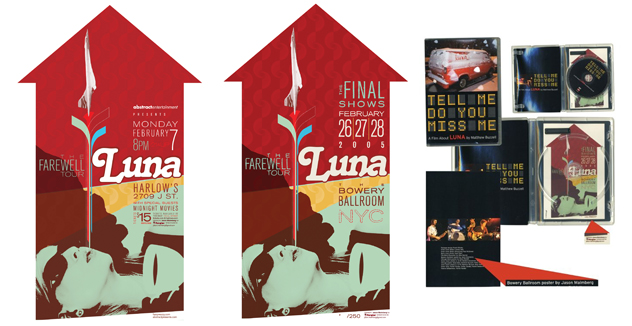
Regardless of who he designs for, he makes it a point to represent the band properly through his design. For each band poster he designs, he’ll listen to the albums to come up with a theme. Each poster should have its own feel.
“You don’t want to be one of those guys who’s basically just churning out art prints and tacking band names on them, because that’s not cool,” he says. “If the bands don’t sound the same, the posters shouldn’t look the same.
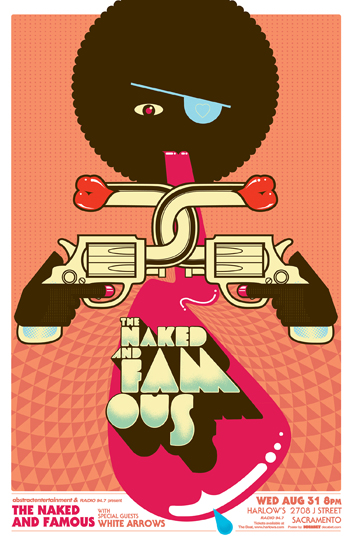
“I don’t try to be literal or narrative,” he says.
That’s how he ends up with posters that look like German ice cream bar wrappers from the ‘70s, like the one he made for the Naked and Famous show. Both fun and grotesque, what looks like a Reese’s Peanut Butter Cup wags its tongue beneath the noses of two interlinked revolvers.
Malmberg explains the look on his website.
“With the band’s bright candy-colored-yet-tasteful aesthetic in mind, I had the idea to try to make something a little European and a lot of odd,” he says. “I started out wanting to make something bizarre in the Polish movie poster vein but ended up with something a bit more like a German ice cream bar wrapper from the ‘70s. A little pop-art, a little glam, a lot of odd.”
Check out Jason Malmberg’s Modern Lehzure at Cuffs in Midtown (2523 J Street, Sacramento) on May 11, 2013. The event is part of Second Saturday. You can learn more about Malmberg at Decabet.com. While you’re online checking out his rad designs, why not check out Cuffs’ home on the Web at Shopcuffs.com?
Local singer/songwriter Justin Farren talks about his music and latest album, and why touring pushes his boundaries, in the best way
Introversion arguably produces the best artists. Those who can spend hours holed up in isolation working on a project often emerge with a gem. Land them at a party or social gathering, however, and they’re quickly making a beeline to the nearest bathroom or unoccupied space.
Justin Farren is an exemplary introvert. If he’s not out backpacking or camping, then he is keeping busy on a project—fixing up his yellow truck, woodworking or writing an album in his garage. For this local singer/songwriter, touring means treading outside his comfort zone.
You might not know it if you saw him perform, but it is nothing short of a challenge.
He was in fact on tour as he was explaining this over the phone, camping with some friends in Bellingham, Wash., and prepping for a show that same night.
Touring, he concludes, is good for him. Given any other circumstance, “I’d want to just go hide,” he says. But after a show, he has no choice but to open up and talk to people.
After three or four more shows along the North Coast, he returns to the Sacramento area for his April 6 CD release show at the CSA Event Center, celebrating the release of his album Another Bluebird Day. Then he’ll continue down to Southern California to promote the album.
This is Farren’s third album. With the exception of his friends Brian Rogers on drums and Emily Kollars singing backup vocals, the album is all Farren, from the guitar, bass, keyboard and shakers to the samples of him pounding aluminum cans. This project sums up his last six months, which were spent recording and mixing the entire thing in his garage-turned-studio at his house.
There is nothing obscure about Farren’s songs. Over immaculate finger picking and slide guitar, he sings with lighthearted honesty about life’s tougher blows, compacted into three to four minute folk pop, storytime songs.
“It has these kind of heartbreaking ideas, and I think that the whole album hopefully places these in a light of appreciation,” he says. “Stand in those moments where it would be easy to be depressed, and just appreciate that you got to have those experiences.”
Farren grew up in Elk Grove when it was nothing more than fields, long before it overdosed on suburban steroids. There are no known musicians in his family, though he says there’s talk of a bad-ass accordionist amongst his ancestry. But somewhere along the way, Farren taught himself how to play music, and he’s been at it ever since.
Within the last five or six years, he’s even been able to make a living off it. He’s opened for the likes of Hot Buttered Rum, Matt Costa and Jackie Greene. He was voted “Best Lyricist” in 2010 by Sacramento Magazine and “Best Musician” in 2009 and 2010 by the Sacramento News and Review.
Farren released his last album, Songs from Spare Rooms, in 2008. Those songs were all written in the two years he surfed couches while his house was being built. (It’s worth mentioning that Farren and his now-fiancée built their house in Oak Park from scratch, inspired by a trip they made to Alaska in 2004.)
“We thought, well, let’s just build a house and not think too much about it,” he says.
It’s where the two currently reside, with three dogs, two of which are lovingly named Pickle Breath and Mr. Pig. Indeed, they have been sources of inspiration. Pickle Breath inspired the song on the album, “Sometimes I Like to Kill Things Too.” Go on to Farren’s music page on Facebook, and you will see several flattering photos of Mr. Pig (who, by the way, needs a new happy home).
“Mr. Pig, the one in all the pictures, is maybe the nicest dog I’ve ever known,” Farren says with utmost sincerity. “So I can’t take him to the SPCA, I have to find him a home.”
Other than Mr. Pig, here is an excerpt of more interesting things that came up in the conversation.
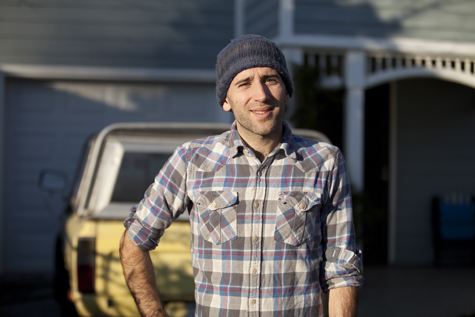
So we were talking about your place in Oak Park, how long ago did you build that?
We started in 2005. It took a couple years, we moved in in late 2007.
What prompted you to do that?
The summer before, in 2004, my girlfriend and I went and worked in Alaska in a really tiny little town called McCarthy, just as something to do. We drove up and we worked in this little town, and a lot of the people up there build their own homes. Over the five or six months that we were there, we were talking to a lot of the locals and kind of getting inspired, like that might be some cool thing to do. We decided we wanted to try it when we got home.
I read that you consider yourself a little bit of an introvert, so I was wondering if touring was a challenge.
Oh yeah, it’s a huge challenge. It always has been and I think it always will be… The more tours I go on, the higher my threshold gets. I am able to comfortably sleep on a stranger’s couch and wake up and make them breakfast, and have a morning conversation with someone that I don’t know. Fifteen years ago that would have been mortifying and terribly difficult for me to even imagine doing.
I think maybe that’s the best thing I can do as a human being, is hopefully raise that threshold. Because the threshold is higher, I’m able to learn from more people and be around new ideas and broaden my horizons. So touring represents all of that, all at once to me, because I’m out and I’m sharing something that’s so important to me with people who have no idea who I am a lot of the time. It forces me to swallow my pride and just do my best and play the song, and hope someone gets on the page and buys a CD or whatever.
Do you generally write first-hand accounts when you write songs?
Yeah, in general. There’s a lot of first-person and talking about stuff that is affecting me. I’ve always admired writers who can read a book and write a song about a character in the book. I feel like I’m a selfish songwriter in that way, I’m always just writing about myself. But that’s kind of all that I have, that’s what comes out all the time.
It’s an outlet, then?
Yeah, it’s the outlet. It’s an outlet, and I try to think of the songs as a byproduct of living, and I want to live a really fun, interesting life, so that I can have fun, interesting songs.
Your music was featured on Laguna Beach?
Yeah, one of the songs I wrote was featured. It’s from the first album. It’s a song I wrote about my band breaking up. I had a piece of shit car, and I didn’t have much going on in my life. And they played that song during a scene in Laguna Beach when they were complaining about their car, and they were driving some fancy Escalade or something, and they were talking about how their car sucks. It’s an awful show. It’s terrible.
What is your least favorite song in the world of songs?
Oh my God, least favorite song in the world? I have to think about it, because that’s such a huge question. There’s just a dense forest of songs that I hate so much. I feel like it’s maybe the biggest question that we’ve talked about. For me to say that I hate it, I have to really mean it.
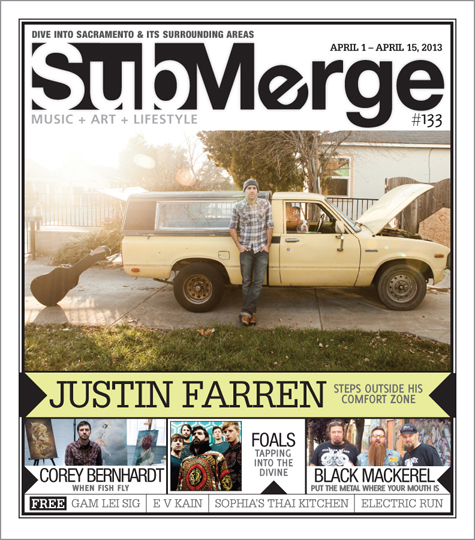
Justin Farren will celebrate the release of his latest album Another Bluebird Day at 7 p.m. on April 6, 2013 at the CSA Event Center, located at 1275 Starboard Drive in West Sacramento. For more info and to order tickets, go to http://justinfarren.com/ or http://www.csaeventcenter.com/
If people started eating a little more like cranes, nature and the economy might be a little better off for it.
This is what prompted the naming of Feeding Crane Farms, a small farming operation with a big vision that sits along a bird grove on the East Levee Corridor in Natomas.
“Cranes are a really wonderful example of what we’re doing with Feeding Crane Farms,” says general manager Shannin Stein. “Cranes eat locally, they eat seasonally.
“They will actually create habitats for small bugs where they live, they’ll tend to those areas and actually cultivate the bugs,” she adds.
Stein oversees Local Food Done Right, an umbrella company that owns both Feeding Crane Farms and Lulu’s Kitchen. The vision behind the two operations is to promote local, sustainable food production, from “farm to fork.”
She, alongside company owner and visionary Brian Shaad, farm manager Antonio Garza, and operations manager Dylan Keith, are part of a team of less than 10 keeping Lulu’s Kitchen and Feeding Crane Farms alive. Needless to say everyone wears a lot of hats, Stein says.
This is a very new operation. After prepping and plowing three-and-a-half acres, and adding all natural amendments like bloodmeal and oyster shell to the soil, the organic farm “broke ground” last September. They began selling crops to local restaurants and grocery stores early this year.
Beyond providing fresh produce for grocery stores, local restaurants and farmers’ markets in Oak Park, Natomas and Cesar Chavez Park, the small team has come up with some really innovative ideas along the way, like Farm to Fork dinners, where locals who already support farmers’ markets and buy organic can experience the talent of chefs in the community who are committed to using local, organic ingredients.
The company recently purchased Steel Magnolia, a commercial kitchen in Sacramento, which they are renaming Lulu’s Kitchen after Shaad’s grandmother, Mary Lou Cayocca. Lulu’s will be accessible to local producers who have recipes but don’t have access to a commercial kitchen or some of the logistics needed to get their products on grocery shelves, Stein says.
The team has its own products it is developing to sell, too. By the start of 2013, you can start looking out for things like arugula pasta, pepper pasta, handmade butternut squash ravioli, squash bread, arugula pesto, and roasted pepper chutney on store shelves. According to Stein, the recipes are being developed as you read.
They also plan to expand into two more properties along the East Levee Corridor, putting an additional 12 acres into production by January and quadrupling their production capacity.
And last but not least, if you’ve caught wind of the first annual Harvest Sunset Celebration, yes, they are planning that as well. But with all the events already happening this fall, they’ve decided to postpone it until the spring.
With so much going on, it’s hard to believe Stein has a moment to breathe, let alone talk through an interview. Yet Submerge somehow managed to catch up with her while she was on a drive through the Midwest.

You guys said you are along the East Levee in Natomas?
Yeah, we’re in North Natomas, and basically it’s called the East Levee Corridor. So it’s a levee bypass system that comes off the Sacramento River out in Yolo and Sutter counties.
Gotcha. There’s a fair bit of ag activity in that region, right?
Yes and no. A little bit further to the west of Sacramento, closer to I-5, there’s a lot of commercial rice production, there’s a lot of big ag. But along the East Levee Corridor, the majority of the land is fallow; it’s not in any form of production.
And so, you guys are trying to cultivate some of that land out there…
Our goal is to basically try and reinvigorate that entire East Levee Corridor, and to create a system and create farms that are duplicate-able. We want to be able to take what we’ve learned in starting our first small three-and-a-half-acre property and we want to be able to basically duplicate it on other properties along that corridor. Then we will create an actual, thriving agribusiness along that corridor to make that area two things: one, less susceptible to development, and two, to basically make Sacramento far more sustainable in regards to food production.
So what kind of stuff do you guys grow?
We have upward of about 30 different varieties of items in the ground at any given time. For this winter, we’ll have a full-crop harvest, we’re not going to take a break this winter. So we have salad mix, head lettuces, arugula. We did tomatoes this summer, eggplant, okra, lots of root vegetables, we grew beautiful beets and radishes, turnips. As Antonio, our farm manager, likes to refer to it, our main property right now is really kind of a salad bowl. There are carrots, onions. Amazingly for our harvest season, part of it has really been experimentation and learning what does well in the soil that we’re working with and getting a feel for crop rotation and our product demands by community.

What’s the plan with Steel Magnolia [now Lulu’s Kitchen], and why did you guys decide to buy it?
Well, as I mentioned, our motto is basically the same thing as our parent company, “local food done right.” And we really believe that “local food done right” doesn’t just mean growing the food locally, it means producing food locally… We want Lulu’s Kitchen to be an incubator kitchen for local producers to come work on their recipes [and] work on their processes. We have fully trained chefs on our team who can help mentor them… At the same time we want to help those producers navigate the often confusing and sticky system of working with the County Health Department and working with the city and learning how to do labeling so it’s FDA approved and how to get your ingredients improved, you know, all of that process. We want help small producers so it’s easier for them to go from concept to the shelf.
I thought I read something about you guys developing your own products to sell in stores, is that right?
We will be, yeah. Absolutely. In fact, you can go to the GOOD market and you can try some of our value-added items. You’ll hear us talk a lot about [value-added items] with small farms in particular. Farming itself is not necessarily a lucrative business. It’s a cash-heavy investment business, there’s a lot of investments needed to really get a farm going and keep a farm operating. Small producers, small farmers really need to have the opportunity and the outlet for additional revenue streams, and so creating value-added products: jams, jellies, breads, sauces, pastas, things along those lines, where the primary ingredients are from your farm, is a great way to do that. So we have a ton of summer squash still out in the field, so one of the chefs on our team is making squash bread.
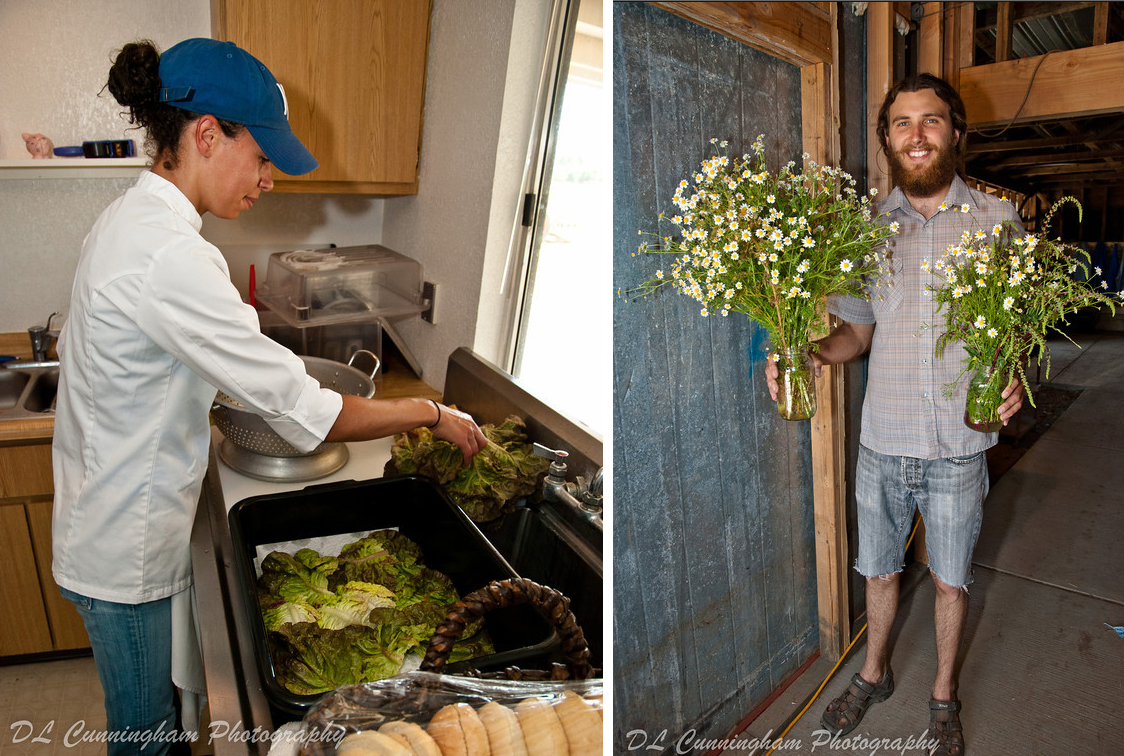
Now Farm to Fork Dinners, whose idea was that?
Well, actually, that was a joint discussion. It started out where once every two months or so, the farmers and myself, just kind of our core team, we were going to one of the restaurants for dinner and we provided food, because the farmers work their butts off, and they deserve the opportunity to enjoy the fruits of their labor occasionally. But in doing that, we also built these really beautiful relationships with the chefs we work with. They have given us fantastic feedback. It started out, actually, with Mama Kim, of Mama Kim Eats, who said almost immediately, “I want to do a brunch.” So we started out with a brunch at Mama Kim Eats, and she said, “I want to do a brunch and I want to focus specific dishes around your produce and your products.” And I was like, “That’s fantastic.” And so Farm to Fork was born. And now we work to do at least one Farm to Fork event each month with our partner restaurants to help bring in business for them on an off-shift. Like at Michelangelo’s, it was on a Sunday night, and we basically helped them triple their sales on a Sunday night.
Do you have an estimate of about how much you produce per season?
You know, we’re putting those numbers together, to be honest [laughs]. But what I can say is we have been able to sustain upward of about 20 to 25 restaurants, the Natural Foods Co-Op, Corti Brothers and three farmers’ markets for this entire season, so since January basically, off of three-and-a-half-acres. And that’s pretty amazing, to begin with.

To learn more about what Feeding Crane Farms and Lulu’s Kitchen have in store, follow Feeding Crane on Twitter @FeedingCrane or like it on Facebook.
Musical Charis’ band members discuss their penchant for collaboration and their mission to bring “real gold” back to the music scene
Two of the core members of local indie pop band Musical Charis are in separate rooms of the same apartment engaged in the same conversation. I am on the other end of the line. We’re speaking together on a conference call. It is a new experience for all of us.
I am talking to Blake Abbey and Jessica Brune, the band’s vocalists, and guitarist and keyboardist, respectively, about their upcoming Oct. 11, 2012 release of FOOL$ GOLD on JMB Records. Despite being miles away, I feel like I am dealing with a family.
They soon will be, I later find out. In addition to being band mates, they are engaged and live in the same apartment, along with the band’s bassist Colin Vieira, guitarist Bradley Abbey (Blake’s brother) and a bunny rabbit. It’s the apartment they are in now as they field my questions. Like family, they are talking over each other, and to make matters worse the reception is lousy. Despite the hiccups, we manage to carry out an engaging conversation as they fill me in on the album, touring and their musical values.
“It seems like a lot of things in music and art, fashion, and pop culture, a lot of it is like fool’s gold,” Abbey says, explaining how they came up with the album title. “It’s just shiny and bright, people want to hold it and touch it, but it doesn’t have the same value as gold.
“But the more that we grow in character and as a band, I think the closer we get to realizing how hard it is, how deep you have to dig for gold and the value of it when you get it,” he says.
Abbey, Brune, Bradley and Vieira spent about a week total, split before and after this year’s lengthy spring tour, recording with music engineer Joe Johnston at Pus Cavern. Now they have an album they hope will stand out against the bounty of overproduced, unoriginal material put forth in the music industry.
It was a collaborative process, a coast-to-coast exchange, Brune suggests. Others, including Jarrod Affonso on drums, Brian Brown on the keys and Shawn King, contributed. “Sunlight Stalker,” the last track on the album, was a joint effort between musician Chris King in Florida and Musical Charis. In a Postal Service-like exchange, King wrote the music, and the band wrote lyrics to accompany it.
The result was an album that Abbey says is quite unique, an attempt to produce “real gold.”
“I don’t think this CD is epic, but I think it’s one-of-a-kind, I haven’t heard anything like it,” he says.
Their fourth release following their 2011 album Ace of Space, FOOL$ GOLD is seven tracks of soothing indie pop and lush harmonies with progressive underpinnings.
It is somewhat more technical sonically than their previous albums, Abbey explains, and the rhythms are more intricate, adds Brune.
Since their formation in 2008, following the Abbey brothers’ and Vieira’s relocation from Florida to Sacramento, Musical Charis has been recognized for their folk appeal. In fact, they have been told on several occasions that they are living in the wrong generation. Brune and Abbey don’t dispute this.
“I think that musically we would be received better 30 years ago. Old people love our music, the folk stuff that we do,” Abbey says. “It’s dubstep nation now, dubstep is taking over the world.”
Whatever they have done musically, it seems to be working. They were nominated for Sammies in 2010 and 2012, for Best Album of the Year and Best Indie Band of the Year, respectively, and in 2011 they won the Best Indie Band of the Year Award.
While this album strays somewhat from that folk sound, Abbey and Brune agree that it is one they will likely revisit in the future. After all, it’s easy to switch up musical directions, Brune says, like whipping up a new batch of cupcakes.
“Some people might not like [the new album],” Abbey says. “But it was fun for me, which is the most important thing.”
If you want to produce something relevant in the art world, or bring back ‘the real gold,’ then you have to get your priorities straight, the way Brune and Blake see it.
Which simply means, “Do it because you love it,” Brune says, even if it means collecting pennies.
The drive, patience and desire all have to be there to move a band beyond the five-year mark, they say.
“The real dream is just living it,” Abbey adds.
The fourth track of the album, “The Gift,” is an ode to friends back in Kansas who are doing just this–living the “rock n’ roll” lifestyle of loving, having fun, being broke and not caring. It’s a fancy-free philosophy the members of Musical Charis put into practice as well.
They primarily work for themselves, sometimes working “under the table,” to make ends meet.
The same love of music inspired the band mates to open the Musical Charis Music School in 2009 in the building next to the Colonial Theatre. It started by just spotting the vacant building and asking the question, “What if?”
To this day, they teach music lessons out of Beatnik Studios, mentoring youth in playing guitar, piano, singing, songwriting and performing. Sometimes they will let their students open for the band.
Those who haven’t seen a Musical Charis show should know that no two performances are alike, partly because they are just as willing to share the stage with anyone who wants stage time. Thus they have become known for their high-energy, unpredictable performances.
“We never plan anything,” Brune says. “We’re not like, ‘Oh, it would be so epic if we did this and that.’ We just kind of roll with it and have fun.”
During a show, the stage is treated as a shared space. The band rotates auxiliary drummers and guitarists onstage or invites other bands to join in. Brune may take Abbey’s guitar mid-song, or Abbey might get on the drums. In any given performance, there might be a trumpet, saxophone, accordion, harmonica, congas or xylophone thrown in the mix. Additionally, just about anyone (with exception of belligerent drunks) from the audience is invited to come up and play an instrument.
“We consciously try to make it about everyone,” Abbey says. “It sucks being in a band playing the same show every night, especially in a small town.”
“I want people to go to [our] shows and be like, ‘We’re going to go have fun tonight and we’ll get to play an instrument,’” he says.
The invitation to participate is an intentional attempt to encourage local community-building, they explain, though they never force their audience members to participate.
So during any given show, 12 bodies might end up on stage. On one occasion an audience member was so engrossed in performing he fell off the back of the stage, Brune recalls.
“Sometimes it’s a train wreck, but [it’s] a beautiful train wreck,” Abbey says.
It’s worth mentioning that this band plays a lot of shows, as many as 150 per year. This includes a 65-day national spring tour they plan annually, in addition to smaller tours throughout the year.
Playing so many shows and tours, including SxSW, it’s no surprise that the band has grown a distaste for the predictable party-goers looking to get blitzed. It’s a common pattern the band has noticed, and it inspired one of the tracks on the album. Against a dreamy, circus-y tune, “Fortune Teller” takes a stab at the molly kids, who equate their live music experience with popping pills.
“It became about a culture of just partying, waking up the next day and starting all over,” Brune says.
No doubt they’ll run into more of that during their West Coast tour following the Oct. 11, 2012 album release at the Townhouse Lounge.
Pill poppers aside, right now the four are contemplating house sitters to look out for the apartment and the rabbit while they are gone. The last tour they went on, their turtle died.
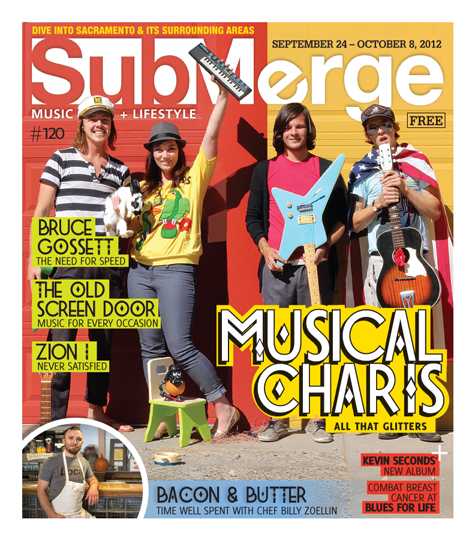
Hop on stage and have a blast at The Townhouse Lounge on Oct. 11, 2012 at 9 p.m. when Musical Charis celebrate the release of FOOL$ GOLD. Also performing will be Autumn Sky, Hey Zeus and James Cavern… And maybe you? Pre-order your copy of the album at http://musicalcharis.com/, and if you’d like to babysit a rabbit, drop them a line.
Exquisite Corps hopes debut album will resonate with the band’s growing fan base
It is exactly 4 p.m. on a Wednesday afternoon when Exquisite Corps’ frontman answers his cell phone.
“Dude, right on time,” Bryan Valenzuela says with a laugh, seemingly impressed.
Observing the magnetic character on stage lead a six-piece chamber rock band during a sold-out show at the Crocker Art Museum, one might imagine that the singer/guitarist of local band Exquisite Corps is unapproachable.
It quickly becomes apparent, however, that this musician is in fact more approachable than most.
After a morning spent painting, and playing a late show for a full house in Nevada City, Calif., the night before, Valenzuela is in great spirits. Exquisite Corps played at the Haven Underground, where they shared the stage with The Still Sea from Nevada City and Pillars and Tongues from Chicago. Apparently people were stacked on each other to watch the show, and Valenzuela had nothing but good things to say about the experience.
“I always love playing in Nevada City,” Valenzuela says. “It’s super cool there, everyone is really chill and interested in music.
“It was kind of crazy to have a show on a Sunday. There was a lot of people staying until one in the morning,” he adds.
Valenzuela has plenty to be excited about. After a few hiccups and lulls in the recording process, which began last summer, the band is now preparing to release its debut self-titled album at this year’s Launch Festival, which Exquisite Corps will be playing for the third year in a row.
For those who ever fell for cellist Gretta Cohn on Cursive’s Ugly Organ, this album is worth a listen. Since the spring of 2010, Exquisite Corps sprung from a cello and guitar duo, with Valenzuela on the guitar and Krystyna Taylor on the cello, to a full band. The current ensemble includes violinists Reylynn Goessling and Kristin Arnold, drummer Robby Dean and bassist Nathan Webb, in addition to Taylor and Valenzuela.
On headphones, the seven-song album allures the listener from the start, enchanting and ominous. Track one, “Tone Poem,” begins with Valenzuela’s voice oozing over the airy, ethereal resonance of an organ, soon joined by the warm hum of the cello. Then violins come in, high pitched and full-bodied, moving the song forward as Valenzuela’s voice reaches fervent, wailing heights.
The subsequent tracks progress in the same vein, commencing with soft, mysterious beginnings, and erupting into opulent, racing symphonies conjoined with Valenzuela’s vocals, impassioned and raging as he sings about subject matter varying from the followers of Dionysus to winter landscapes. Following “Tone Poem” is “Light As a Feather,” which appeared on local music blog Live in the City of Trees.
Now the band is releasing previews of the album, song by song, leading up to the release show.
To record the album, the band of six spent a considerable amount of time at Hangar Studios with music engineer Scott McChane, who has worked with the likes of local acts Sister Crayon, Agent Ribbons, Chelsea Wolfe and Ellie Fortune.
Valenzuela had his hands in both the recording and mixing processes, ensuring that he could guide the direction of the final product.
“I was there for every single aspect of it,” he says. “It’s expensive to record, and we wanted to record as professionally as possible and make it sound as good as we could with what we had.”
Exquisite Corps’ songs begin with Valenzuela, who writes the music, working through the melodies in his head. Then he approaches the others to arrange the songs. Each member brings something to the table, coming up with pieces to add or ways to solidify the songs.
The progression is not unlike how Exquisite Corps originated, with some string compositions Valenzuela wrote a while back and wanted to put into action.
Valenzuela grew up in Orange County, relocating with his parents to Placerville when he began high school. Around the same time he took up the violin at school, and was drawn to chamber music ever since. He studied music theory in college. When he was the singer/guitarist of former local band Call Me Ishmael, he wrote string accompaniments for the band’s CD release show.
It went over well, but for some reason the band never used strings again after that performance. He wanted to do it again ever since.
“I guess I was just in love with the sound,” he professes. “The string instruments can be, in my opinion, super versatile. They can be really sweet and beautiful, and then they can be really gritty and dirty. There’s so much range there that is great to utilize in music.”
Upon running into the right people at the right time, likeminded people like Taylor, Valenzuela fell upon an opportunity to start a chamber rock band, and thus Exquisite Corps was born.
They eventually recruited Dean and Webb, who played with Valenzuela in Call Me Ishmael.
“[The band] kind of took on a life of its own, in some ways, just by having the thought a long time ago,” Valenzuela says. “Sometimes things just fall into place, I guess.”
Though Exquisite Corps has come a long way since its beginnings, gaining a loyal following in Sacramento and playing sold out shows at venues around town, Valenzuela remains modest about his musical capabilities. The following is an excerpt from the phone conversation between Valenzuela and Submerge.
It sounds like you had played in a lot of other bands prior to Exquisite Corps as well?
Yeah, some bands here and there. Nothing really that notable, not that I’d like to talk about [laughs].
OK, that’s fair.
Because…when you are younger you are in all these different bands, and later in life it’s a little embarrassing.
But what would you say your thoughts are on your progression, anyway, musically, from Call Me Ishmael to Exquisite Corps?
I don’t know, just more experience as far as songwriting and how to arrange music [goes]. Since that band I’ve been studying how to arrange for string instruments, and I’m not a classically trained musician. But [I’m] learning, maturing, trying to ensure that the content of the music is all together. When you are younger, you’re just super excited, and you’re throwing everything out there.
Some of your songs sound almost soundtrack-like on the album. I was particularly thinking that [about] “Windswept” and “I Want What I Want.” Do you ever visualize storylines as you’re writing the songs or writing the lyrics?
Yeah, totally. Either there’s a specific story or it’s like a loose story and images, you know? Maybe it’s a non-linear narrative or something. It may not always come through in a lyric but it’s something you think about when you’re writing or even when you’re playing it. You know who I thought is really good is Neko Case.
Yeah, I love her music.
Dude, she’s so rad. But she tells these stories, and I don’t really know what the story is. The story is totally a non-linear narrative. I know there’s a story in there, and it kind of draws you along.
Would you say that’s the same with some of your songs as well?
I’m always inspired to do that. I’m always inspired by that kind of thing.
Did you ever receive vocal training? You really belt it out during some of your songs, and I was wondering if you’re voice ever gets strained.
In college I took choir [laughs]. I wouldn’t say I ever had vocal training, though. It’s just listening to other singers and watching other singers. I have no formal training in singing. And actually, this wasn’t even something I aspired to do at first. I was mostly a musician, a guitar player most of the time. I was in band in high school, and I was never a singer. But you start playing with people, and no one wants to sing [laughs], that’s pretty much how I started singing. You just try to get better, you just work on it every day and keep working on it. I’m sure I was really bad, I know I was really bad when I started singing… As far as vocal straining, I’ll just drink more water the next day and everything’s fine.
What kind of music are you listening to these days?
Shit, I’ve been listening to PJ Harvey. I kind of got obsessed with the last PJ Harvey record [Let England Shake]. And then I’ve totally been listening to tUnE-yArDs, even though we’re not even close to that kind of music, it is pretty awesome. I mean, we’re not that type of music but I do love it. Beforehand I was listening to Elliott Smith. I always listen to a lot of different stuff, like old stuff and new stuff. The Beatles to Blonde Redhead. I love David Bowie. I was listening to David Bowie coming back from Nevada City the whole time. It kind of keeps you going. It’s a long drive and it was late.
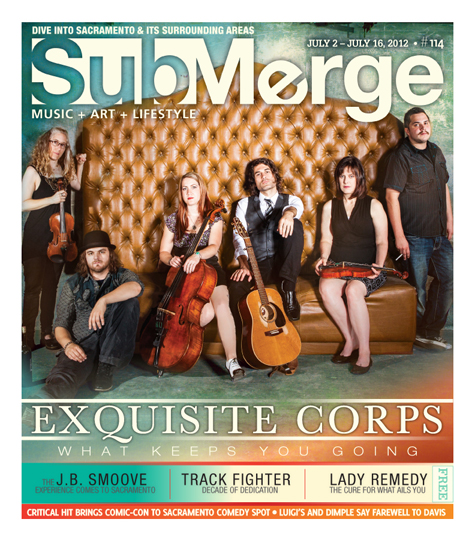
Exquisite Corps will celebrate the release of its self-titled album as part of the Launch Festival on July 25, 2012. The show will take place in front of the MARRS Building in Midtown. Doom Bird, The Honey Trees and I’m Dirty Too will also perform. This is a free, all-ages event and starts at 5 p.m.
International Skateboarding star Joey Brezinski’s Manny Mania returns to Sacramento
Guangzhou, China, is a prime location for skateboarding. Everything is brand new, there is marble everywhere and the likelihood of getting kicked out for pushing around on a board is slim. That’s because security guards are too busy watching in awe. So says pro rider Joey Brezinski, anyway, who visited there recently.
“It is one of the best places I’ve ever skated in the world,” he says over the phone from his home in Venice, Calif.
While the sight of Brezinski flipping tricks may be foreign in parts of China, skateboarding is catching on in many regions around the world. Whether he intended to or not, Brezinski has facilitated the process by coming up with a unique skate contest that, in its sixth year running, now spans five continents and 12 countries, attracting participants anywhere from the United States and Chile to Sweden, South Africa and the United Arab Emirates. Red Bull Manny Mania is a skating competition concentrated on the manual, one of the most basic, fundamental skating tricks around.
There are nine amateur qualifiers taking place in the United States alone. Sacramento will host a Manny Mania qualifier this month for the first time in three years, being the only qualifier taking place on the West Coast in 2012.
For those unfamiliar with skate-speak, a manual means that a skateboarder balances on one end of the board while the other end comes off the ground, moving forward all the while. In other words, it’s the skateboard version of a wheelie.
It may seem relatively straightforward, but it’s harder than it sounds.
“It’s a lot more technical,” Brezinski explains. “Instead of having to go big or find a gnarly ramp or handrail, I try to stay low to the ground and maneuver the board more.”

(Photo by Giovanni Reda/Red Bull Content Pool)
The competition demands creativity. Beyond performing the manual, competitors are expected to tie in a variety of other skate tricks into a smooth combo. A sequence might sound something like: a perfect nose manual to late flip on the high box. Again, to the non-skater this is gibberish. The bottom line is, this stuff gets complex.
To top it off, each round lasts eight minutes, during which the rider has to maintain fluidity. The rider who demonstrates the most consistency and control, in addition to the most tricks, wins.
“It’s a lot of balance and endurance, I like to say, because the contest is like running a marathon,” Brezinski explains. “You try to do as many tricks in eight minutes as you can, and it’s pretty exhausting.”
Thus skaters like Youness Amrani come forward–the 2009 Manny Mania championship winner–who, according to Brezinski, are taking things to the next level. One of the most memorable big stints Amrani pulled involved a kickflip manual backsmith, Brezinski says.
As the competition has gained popularity, more and more riders have come to the table to compete at both the professional and amateur level. Big names like Kenny Anderson, Danny Montoya, Daniel Castilo, Brandon Biebel, Jason Dill, Eric Koston and Stevie Williams have shown up in past years. The contest has also brought names like Sewa Kroetkov to light. He was relatively unknown in the skating world until he gave Brezinksi a run for his money in last year’s competition.
What started out as a skate contest in Venice, Brezinski’s hometown, has evolved into a worldwide competition. Brezinski, who made his name debuting in the film Hello JoJo for the French company Cliché Skateboards in 2006, approached Red Bull in 2007 with the idea of creating a manual skating contest. Red Bull was immediately on board, and the result was Manny Mania.
“It was something I always wanted to do,” Brezinski says of the competition.
In addition to the nine amateur qualifiers taking place in the United States, others are cropping up across the globe to draw new talent into the competition. Riders as young as 14 are entering the contest. Each nation’s finalist will compete in New York’s world final in August at Coleman Park; and the winner of the world final will return the next day to compete in the Manny Mania Pro Event.
Since its inception, winners have included Ronnie Creager and Eli Reed. Brezinski won the Venice competition in 2007, in addition to the pro final in 2008 and again last year.
Some years have proven more challenging than others. For instance, in 2009, Brezinski tore ligaments in his ankle prior to the competition while shooting the TransWorld skate video Right Foot Forward.
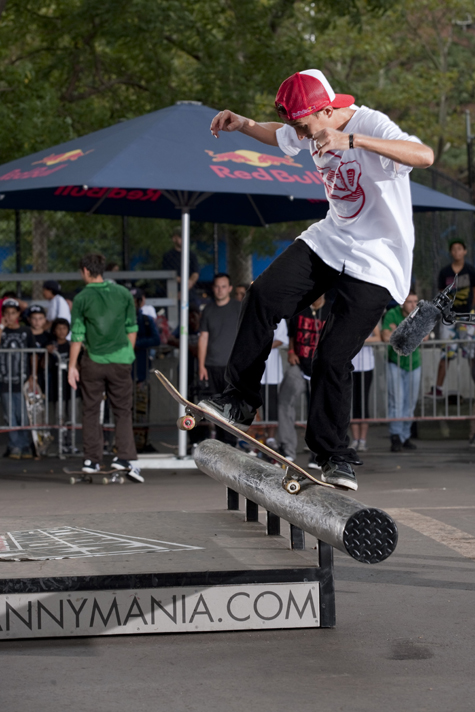
(Photo by Jody Morris/Red Bull Content Pool)
Last year he shot another video for the X Games Real Street contest. Aside from Manny Mania, Brezinski isn’t one to enter skate contests (it means more time spent traveling and less time skating the streets), but last year he made the exception to shoot the one minute of skate footage that, if it had been chosen, would have aired on NBC during the X Games.
“It was insane,” he recalls.
This year he is shooting yet another video, apparently, this time for Cliché. It’s for a sponsor he loves. Whereas other brands don’t provide him many travel opportunities, Cliché allows him to head to Europe every year for a visit. Still, anticipating this year’s competition, he vows to take it easier than he did in 2009.
Plus, he has energy to save for another big endeavor, namely his new business, Andale Bearings, which he just started with co-owner Paul Rodriguez earlier this year.
For Brezinski, the business world is new territory.
“Like skating, every day is a new trick,” he says.
Commanding a business with a mission to put the best bearings into skate wheels means fewer hours on the road and more hours at home in Venice. That leaves a couple hours a day at the skate park.
Yet, while exotic locations like Guangzhou will always have skating allure, Los Angeles remains one of his favorite spots to skate. Not only is it where the first Manny Mania went down, it’s also where he started out on a board at age 8 or 9.
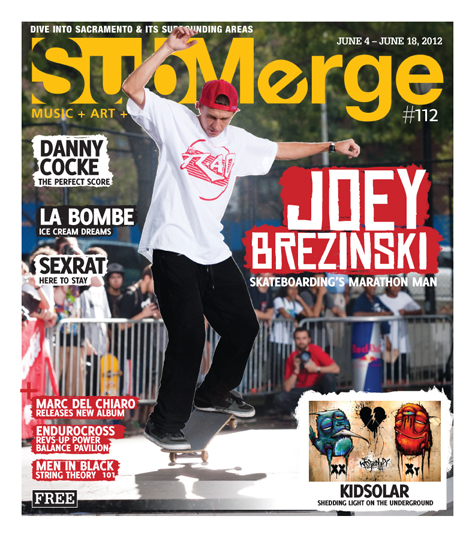
Red Bull Manny Mania’s only West Coast qualifier will take place in Sacramento on June 9, 2012 in front of the MARRS Building (1050 20th Street). The event is free and open to the public. Skaters can register ahead of time at FTC in Sacramento, PLA in Folsom or at the event starting at 3 p.m. Skating starts at 4 p.m. To keep abreast of all things Joey Brezinski, follow him on Twitter @joeybrezinski.
From clutter, artist James Mullen assembles pieces of grotesque beauty
If you are looking for art that is pretty, don’t expect it from James Mullen. This artist is not out to make art for beauty’s sake.
What is more important to him is to turn heads, in the same fashion that heads turn when people hear the sound of a car wreck, whether they want to see the carnage or not.
If he has caused the observer to ask questions like, “What was he thinking?” or, “What the heck was he up to here?” then consider the piece a success.
“To have a piece that is a bit dark and disturbing is to be that car wreck,” the Sacramento native says. “I’m not looking to hold up an object for admiration; rather, I’m looking to grab someone’s attention, grab them by the lapels and prevent them from looking away, almost to rivet them in place.”
It is appropriate that he should mention rivets, considering his upcoming exhibition, Jagged Edges, at Bows and Arrows, a collection of three-dimensional nail fetish pieces that incorporate wood, nails and doll parts. This body of work, inspired by Congolese nail fetish pieces displayed in the de Young museum in San Francisco, will hopefully make people’s hair stand up, Mullen says, as it is one of his “darker” collections.
A personal favorite is Nail Fetish #8, which is almost Christmas tree-like in a grotesque way. The flayed skin of a doll is wrapped around a triangular piece of wood, a thick spiral of nails curling around it. A telephone rests on the doll’s arm, and in its opposite hand it holds a compass. The piece is whimsical and heavily influenced by Dadaism, Mullen says.
“I find it very powerful and a little disturbing, perhaps, which is what I’m going for,” he adds.
To be clear, Mullen is an abstract assemblage artist. His artistic process is very organic, he explains, in the sense that the objects he starts with will dictate his final product. He may grab one piece from the rafters in his studio, and the rest of the work comes together around it.
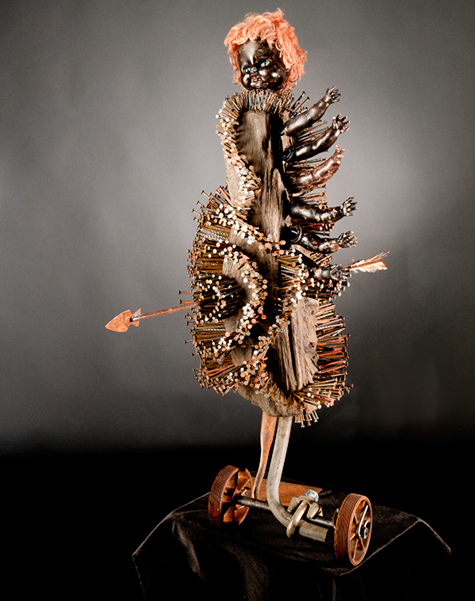
Nail Fetish #4
“I don’t know where [the piece] is going or where it’s going to end up, but I just start,” he says. “Starting [gets] the creative juices flowing, and the ideas start moving through my head, and the piece will grow from whatever object just comes to hand.”
As far as what comes to hand, it is an eclectic mix of items that form Mullen’s artistic palette. In this way he is also a collector of odd and interesting things. Animal skulls, for instance, pieces of wood, a rusted bike frame or a horse’s jaw are considered treasures. A goat skull he found on the side of the road was integrated into one of his nail fetish pieces. Often these are objects he finds on the Walker River alongside U.S. Route 395 near his home in Grass Valley, or on bike rides, at garage sales or junk stores.

Nail Fetish #8
Unable to see Mullen’s studio with the naked eye, Submerge asked Mullen to describe his studio in Grass Valley. He did; he also sent pictures of it.
Work surfaces and shelves disappear beneath seas of hand tools, saws, canisters, tubs and boxes. Odds and ends are piled high, while a web of doll heads, cables, tubing and a picture frame hang from the ceiling. This is where he has spent 20 to 30 hours per week creating his nail fetish pieces. From this clutter emerges Mullen’s works of art.
Each work comes together using epoxy, nails, rivets, screws, wire and pressure. The natural tarnishes of the pieces he uses are integral to the characteristic of his work, he explains. In order to preserve the rust and grit of his assemblages, he chooses not to weld, though he knows the skill.

Nail Fetish #2
“I really enjoy the patina of age that items show during a lifetime of wear and weathering and what have you, so I don’t weld,” he says. “I do wear out a lot of drills.”
Assemblage was not always Mullen’s forte. Once upon a time, he worked with clay. In fact he has worked with it on and off for 40 years, since he first began sculpting in high school.
Like a writer becomes afflicted with writer’s block, or an artist walks away from a painting, he too experienced a dry moment sometime in 2007, when he no longer wanted to work with clay. He stopped midway through a sculpture, and for four months did nothing more with it or any other clay works.
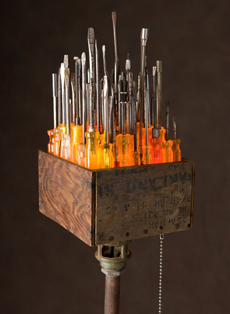
Screwdriver Nitelite
Still, he knew he wanted to create art. So, while standing in his backyard, his eyes fell upon piles of rusty fencing, wood and sheet metal, and he decided that these pieces would become his new media. He has been an assemblage artist ever since.
Whoever takes a Mullen piece home has little control over how to display it, because Mullen already has that taken care of. Often he intentionally builds a base into his pieces so he has leverage over the angle it is seen, whether they are built onto pedestals or elevated with wooden chair or table legs. This creates a towering effect.
“Once you make a piece and send it off into the world, you don’t have control anymore on how it’s going to be treated…what people are going to think of it. It’s all out of your hands,” he explains. “But by building the entire piece and including the base, I at least have some influence over the perspective of which it’s viewed.”
Practicality doesn’t always come into play in his pieces, however. As he is largely influenced by the Dada school of thought, his pieces are meant to be illogical and nonsensical.
“I don’t overintellectualize art. I try not to dissect it,” he says.
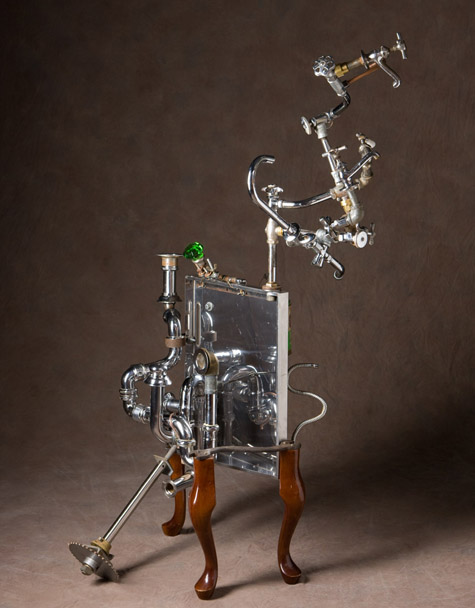
The Plumbers Daughter
Take one of his older pieces, Plumber’s Daughter, for instance. Plumbing pieces, a section of a steel grill, a doorknob and a lard bucket are arranged vertically atop cherry wooden table legs. There is no rhyme or reason to the bathtub-like creature, except that it was dedicated to Mullen’s wife, who is, in fact, a plumber’s daughter.
While it is a head turner, there is little other meaning behind it. In the same vein as Rube Goldberg, these are little steps to absolutely nothing, he says.
Bows and Arrows will host an opening reception for Jagged Edges on Friday, June 1, 2012 from 6—9 p.m. Find out more at http://bowscollective.com/. You can delve deeper into the mind and art of James Mullen at his website, http://jamesmullenartist.info/.
Photographer Jesse Vasquez celebrates the human form in his third series, Stone
From the ruins of a tanked economy arises a booming art scene. When Philadelphia had little else to offer, the city turned to its creative minds, dumping money from its coffers into the arts. So it goes–a downward spiral can only last so long before things start looking up.
This is the experience freelance photographer Jesse Vasquez remembers. Nine years of artistic exposure in this almost bankrupt city provided him all the ripe conditions needed to develop his first body of work before returning to Sacramento. He found dancers and willing subjects to photograph, and had unlimited access to a three-story house replete with lavish furniture and a roof garden of exotic plants to use for props.
He completed the latter half of that body of work in Sacramento. The result was an impressive portfolio of black and white photos: capturing the rocking motion of an unclothed couple’s entangled embrace on a couch, a hand moving a flower across a naked body, and a nude pregnant woman seated beneath a halo of moving lights. In each photo, Vasquez mastered the art of stretching time.
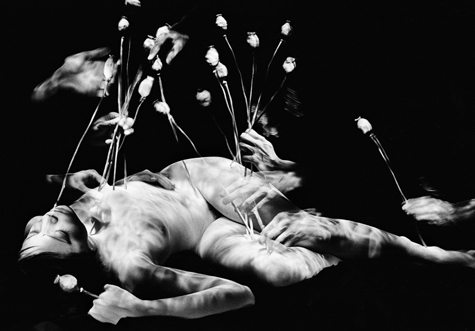
Aurora
Years later the Sacramento native is preparing to show his third major body of work, Stone, at the Milk art gallery in Midtown this month. This work also focuses on the naked body. Yet while his older pieces communicate the experience of passing through the body, Stone approaches the nude body in a very graphic way, he says, focusing on shape, form and solidity.
Jargon rolls off Vasquez’ tongue fluidly as he describes to Submerge over beers his experience as a photographer and why certain subject matter appeals to him.
His compositions using nude bodies are arguably his most stunning pieces of art. To understand where he is coming from, understand his frustration with the way people conceive the human body in art. People are more receptive to nude bodies in other art forms, he argues, yet when presented with a photo of a naked body, they pay little attention to tones, lines or composition.

“[There] is an utter childishness about standing in front of a picture of a naked person,” he says. “People have a real fantasy life about a nude body depicted in a photograph.”
It seems strange, he says, considering photos are nothing more than pigments arranged on a piece of paper, two-dimensional representations of light reflecting off of something, in this case bodies.
“Everybody has a body,” he adds. “Everybody interacts with the world through [their] senses.”
Vasquez shot Stone to reflect painterly and sculptural qualities. The photos focus on various sections of the human form: pale, powerful bodies contorted with arched backs. Yet, unlike the pristine, bleached sculptures that might come to mind, these are human bodies with muscle details and hair, their nuances exposed.

Like Philadelphia, Sacramento also played a role in his formative years as a photographer. It was in the bathroom of his drinking buddy’s apartment in Midtown where he got his first taste of a DIY darkroom, after all. Exasperated with Vasquez relentlessly tinkering with his gear, his buddy eventually gave him an old Pentax film camera, spurring Vasquez’ interest in photography. Vasquez soon enrolled in classes at Sacramento City College. That is where he experienced his “a-ha” moment, when he was asked to shoot an assignment by painting with light. The rest is history.
While you may not have seen his nude works, there is a good chance you have spotted the photographer’s work around town. In fact, if you have been a Submerge reader since its earliest years, then you may recall an image of Sacramento band Agent Ribbons on the cover of the first issue. It’s the one where the duo is posed stoically on a round throw rug, instruments in hand. Vasquez shot the photo. Otherwise, you may have seen his work while browsing Midtown Monthly or the Sacramento News & Review.
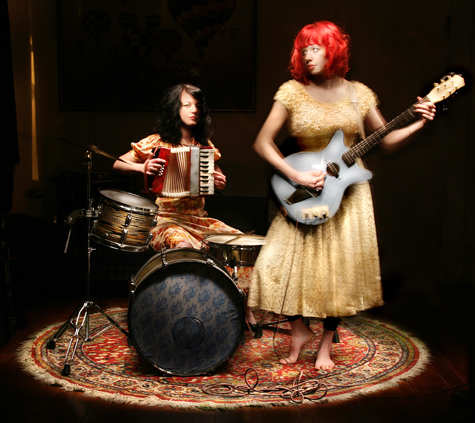
Agent Ribbons (used on cover of Submerge No. 1)
Perhaps the greatest advantage to being a freelance photographer is the access to unique experiences that comes with it, he discloses. He has attended Adobe conferences for marketing-related work, passed time in Berlin, Tokyo and Chicago. He has been a part of documenting Sacramento’s local music scene, including the likes of Ricky Berger, Mike Farrell, Phallucy and Exquisite Corps, in addition to Agent Ribbons. He has been asked to shoot political gigs, snapping shots of legislators stopping mid-conversation to reveal an effortless grin. As long as Vasquez holds a camera in front of his face, no one questions him.
What a dreamy existence, right? Not always. The reality that comes with freelance work is there is no steady income to rely on, and it’s a matter of waiting for customers to fork over cash. And if no one is interested in spending, then it can be a sorry day, week or month. In Sacramento, people are particularly reluctant to open their wallets for artwork, Vasquez says.

Exquisite Corps
“You end up being like a soccer mom to your work,” he says jokingly, meaning he has to haul around his pieces from exhibition to exhibition until someone buys something.
Still, he spends his time doing what he loves, making art.
“Art is my commitment that I will never murder anybody,” he says.
This may sound odd at first, but as Vasquez explains, it rings true for him. Prior to his infatuation with photography, he was within days of entering the Air Force linguistics school in Monterey.
His recruiting officer reassured him, “You’re not going to have to shoot anybody… You’re just going to translate and pass it on.”
That’s when he had an epiphany, Vasquez remembers. Even if he wasn’t the one toting a gun, he was still part of “the machine,” only he was passing on the burden of killing to someone else.
“The entire organization is designed to enforce your will on other people, other cultures,” he says. “It’s just spreading out the responsibility [so] that nobody feels too bad about it.”
So the day before he was supposed to leave, he instead told his recruiter he wasn’t going. He signed a paper, never looked back and has lived as an artist ever since.
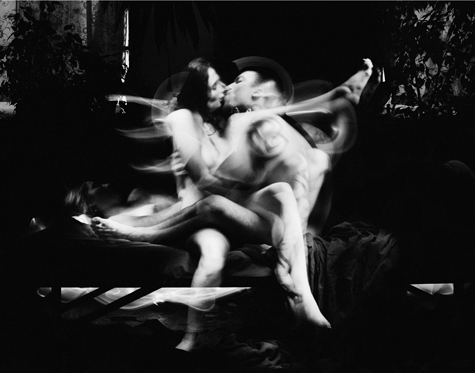
Embrace
“Art is a conversation with whatever, with your materials, with your culture, your people,” Vasquez says. “Sometimes people buy it, sometimes they don’t buy it, but you spent your energy adding something to the world, versus trying to mash the world into the shape you agree with or coercing it to comply with your will.”
When cities are left in shambles, whether it is the result of bombs, zealous greed or dilapidated economies, we can only hope that there will still be artists left to shed light into the void.
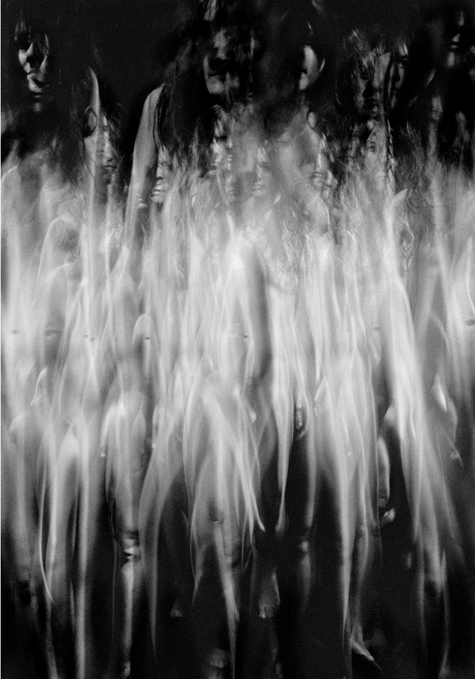
The Forest
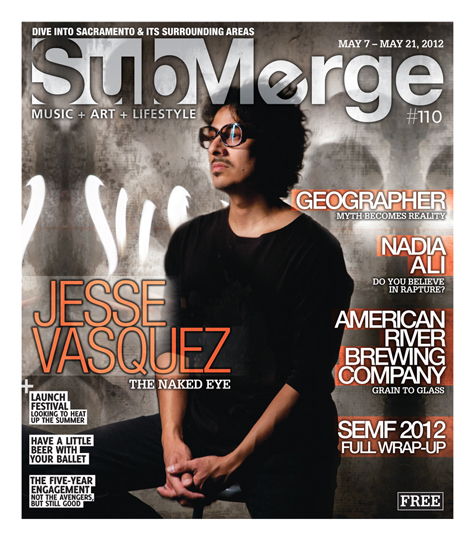
Sol Peligro’s Sam Peligroso puts forth a solo EP
The frontman of Sacramento’s most renowned Latin bands wasn’t planning on making a solo rap album, but it just sort of happened.
Age 40 seemed like as good of a time as ever to do it, says Sam Peligroso, the frontman of local bands Sol Peligro and Blazing Hangovers. One day in the recording studio, he just started flowing in Spanish, and everything spiraled from there, he explains to Submerge over the phone.
Blazing Hangovers is like a Tex-Mex tribute band, Peligroso says, while Sol Peligro blends the sounds of reggaeton, cumbia, salsa and alternative rock. In the same vein, Latin beats are the backbone of Peligroso’s seven-track album, the Sam Peligroso EP, engineered, mixed and produced by Reckless Reaction. The accordion dominates one track, another is woven into an intricate guitar solo. Peligroso makes it clear, however, that the raps and the choruses are all him.
The way he sees it, this album is a fusion of everything he has learned about music up to this point. For him, the EP is a celebration of his 20-plus years in the local music scene, he says.
“This is me,” he says. “This is the best representation of who I’ve become and who I am.”
The album may not feel like a celebration per se, though it most certainly sheds light on understanding what Peligroso is about. True, in person and over the phone he is charismatic. He’s got a slew of jokes up his sleeve, and he’ll laugh at each one of them. In exchange for getting this story on the cover of Submerge, he offered to give donkey rides and park a taco truck in front of the office. But the Sam Peligroso EP exposes not the jokester but someone angered by what is taking place around him, like people being wrongfully accused of crimes, the unsettling treatment of immigrants and the “system” in general.
“I’m not a political person, I’m not trying to say I am a revolutionary,” Peligroso says. Yet immigration and border laws are enough to get his blood boiling, particularly considering his roots. His father migrated to California from Jalisco before he was born, where he met Peligroso’s mother. Later the family moved to Woodland, Calif., where Peligroso grew up.
Mexican American pride has always played a major role in Peligroso’s life.
“I’m not hate whitey at all,” he says with a laugh. “[But] I’m proud of my culture and I feel that I represent it really well.”
His mother had a lot to do with fueling his musical tastes, starting with when she took him to see Saturday Night Fever when he was 8.
“When I saw John Travolta on the damn screen, I thought, ‘That guy’s fucking cool, I want to be that guy right there,’” he remembers. “He’s not a musician, but all eyes are on him.”
Throughout Peligroso’s childhood, his mother would play anything from The Beatles to mariachi music around the house.
“When I was growing up, it was me and radio,” Peligroso says. “That played in the kitchen every time [my family] was cooking breakfast and stuff.”
His first recording was on a 45 record when he was 8 or 9 years old. His mom bought him the 45 with the song “Pacman Fever” on one side and the instrumental recording the other.
“My first recording was my own version of ‘Pacman-fucking-Fever,’” he says.
“I wish I still had it,” he adds with a laugh.
In seriousness, his music career began in 1992. Influenced by the likes of Run DMC and Easy Boys, around age 21 he formed a rap trio called BRC. After his stint with BRC he decided to revisit his Mexican roots, and formed the Latin-based band Raigambre. After that project folded, he then formed Sol Peligro and Blazing Hangovers, both of which he still performs with.
Staying true to his Mexican roots, Peligroso’s solo album release is set for Cinco de Mayo. As someone who considers himself an ambassador of Sacramento’s local Latin music scene, this would only make sense.
“I’m going to be honest with you, my show at Blue Lamp that night is going to be the only show where you’re not going to hear one single cover tune,” he says.
“I’m not trying to talk down to these restaurants like Vallejo’s, where they’re hiring people to play Santana the whole night,” he adds. “[But] that’s not how I want to be described, that’s not how we want to be described. We have originality.”
For his live performance, expect old school simplicity, Peligroso says–an accordion player, a hype man, a DJ, a conga player and Peligroso himself.
In an interview with SN&R back in 2009, Peligroso griped about what a shoddy job Sacramento media has done giving local Latin music any exposure. In his eyes, little has changed three years later, and he is still fighting to change that.
“Sacramento media sucks when it comes to giving the Latin music scene its due,” he says. “You can print that. I don’t give a shit.”
For instance, both Sol Peligro and Blazing Hangovers have been nominated simultaneously for Sammie awards.
“Why is it that both my bands [get nominated] all the time when we play like, once a fucking year?” he laughs. “I’m in both bands, what are you doing?”
“Basically what I’m trying to say is that they’re so out of tune with the music scene as far as Latin music [goes],” he adds.
Peligroso views local radio stations with equal distaste. As pivotal as radio was in his upbringing, he no longer listens to it, namely because the radio doesn’t promote local acts, he explains.
“The media is a big influence man, that’s it, [and] I don’t want to have to start a revolution here,” he says.
If there is any positive outcome of all this, it is that this lack of exposure has intensified Peligroso’s drive to put his music in the spotlight, and he has seen a lot of success. He is grateful that Sol Peligro has won three Sammie awards and will be inducted in the hall of fame, he says.
When asked why he chooses to stay here given the media’s skewed taste, he answers simply, “Well, I don’t run away from things.”
“Trust me, I can easily go to L.A. [or] I can go to New York and probably be more prosperous in doing what I do,” he adds. “But my thing is, this is my home. So if I do that, it’s almost like I’m being run out of my own home. I would never just pack up and leave because I’m not getting my way.”
Thus, Sacramento continues to serve as Peligroso’s home base. Meanwhile, his message to Sacramento remains: listen up! Now is as good of a time as ever.

Still listening? You should be. Sam Peligroso’s EP release will take place at Blue Lamp on May 5, 2012. Also playing will be Olmeca Desperados, La Noche Oskura, O Street Dub, Mahtie Bush and DJ Los. Doors open at 8 and tickets are just $7 in advance. For more info go to http://bluelamp.com/.


